Margaret: Archduchess of Austria, Queen of France, Princess of Spain, and Duchess of Savoy
The lessons, loves, and losses that formed the future Governor of the Netherlands
Welcome back to the Ruling Ladies of the Low Countries series! If you missed Part I and the story of Mary of Burgundy, the final sovereign Duchess of Burgundy, you can read it here!
When Mary of Burgundy died, Mary and Maximilian’s daughter Margaret was a toddler, on her way to be raised in France as the wife and future consort of the thirteen-year-old Prince Charles.
Maximilian Habsburg was Regent on behalf of Margaret’s brother Philip, who was then five years old. The little duke’s guardianship was first wrested away from his father by the Estates General of Ghent, who kept Philip a quasi-prisoner, until Margaret of York, Mary of Burgundy’s beloved stepmother, managed to gain his custody.
Margaret of Austria was embarking on her journey alone: unbeknownst to everyone, France was only the first stop on an international royal tour that would have her ping-ponging across western Europe for almost two decades.
Margaret’s marriage didn’t turn out as it was supposed to. Nor did her second, nor her third. Her young life was defined by political upheavals and personal tragedies. And while her eventual rise to power in the Netherlands could not have been foreseen by anyone, her later success followed directly from her experiences in these early marriages - particularly the exceptional training she received from the powerful women who received her at their courts across Europe.
It was only in the process of putting this post together that I realized how much detail Margaret’s story demands: she’d travelled more widely and experienced more loss by the time she was twenty-five than most of her contemporaries did in a lifetime.
So today I am presenting the first part of Margaret of Austria’s story. Between her birth in 1480 and her rise to the Regency of the Netherlands in 1507, Margaret had been Archduchess of Austria, Queen of France, Princess of Spain, and Duchess of Savoy. She married three times and was educated by the greatest female political leaders of her era. That feels like plenty of story to tell - and digest - for one sitting!
So, it’s 1483 and Margaret of Austria is a scared three-year old, being shuttled across the Low Countries, in mid-winter, to live with strangers in a strange country.
She was received by a French embassy led by the king’s daughter, Princess Anne of France, Duchess of Beaujeu. On her father’s orders, Anne demanded that Margaret be stripped nude so that Anne could inspect the child. Her body deemed acceptable, Anne delivered Margaret to the French court.
The Toddler Queen of France
While the idea of a toddler getting married is downright chilling, I can at least confirm that this was a marriage only in name: Margaret was raised by Anne of Beaujeu and well cared for, surrounded by royal children, many of whom were distant relatives.1 As dauphine and then queen of France, Margaret gained a household which Anne filled with women of perfect virtue and reputation. Margaret gained a fabulous education: we can trace Margaret’s love of reading back to her time in Anne’s circle.2 But Margaret was raised fully in the interest of France, and so she learned little of her own country. Her language, dress, and courtly training were all decidedly French.
Margaret’s Sister-in-Law: Anne of Beaujeu
Anne was the eldest child and daughter of Louis XI, raised to serve her father’s and then her younger brother’s reign. At fourteen Anne was married to the 36-year-old Pierre of Beaujeu, and when Louis XI died nine years later, Anne and Pierre launched a political campaign to place Anne in power as Charles’ governor. Anne’s supporters pressed her case at the 1484 Estates General meeting, where she secured control over the upbringing - and policy making - of Charles VIII. The sixteenth-century French chronicler Brantôme would later say of Anne that “she governed so wisely and virtuously, that she was one of the great kings of France.”3
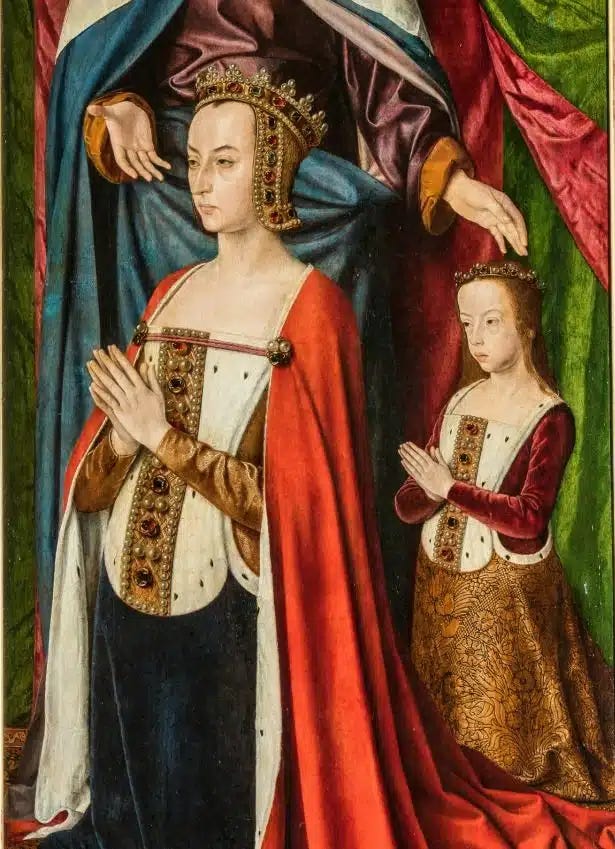
Anne is increasingly recognized as central to the development of early modern female rule and politics, and she was the most important woman in young Margaret of Austria’s life. For nine years Anne directed Margaret’s upbringing alongside the children who would go on to rule Europe decades later. Louise and Philibert of Savoy, Anne’s daughter Suzanne of Bourbon and sister Jeanne, and the future Louis XII of France all took part in the “school of future rulers” under Anne’s watchful eye.4
In the few letters that survive between Anne and Margaret, Margaret wrote to Anne as a mother figure, and understandably so. While Margaret of York continued to write to Margaret from the Netherlands, it was Anne of Beaujeu who Margaret assumed would remain the great female figure in her life.
We have a sense of Anne’s strategies for political women thanks to a treatise that she composed for her daughter Suzanne. Written around 1505, the Enseignements offered guidance for women in power based on female virtue, Christian morality, and the example of powerful women of the past.5 In early modern book culture, reading was social, and any work worth reading was distributed, read, and discussed within social circles. Margaret and her cohort would have been well acquainted with its teachings, as they were other manuals for women. (The Enseignements was not the only manual of its kind - another work, Le Parement des Dames, was dedicated to Margaret herself, and Suzanne of Bourbon also owned a copy.)
In many ways a product of Christine de Pizan’s theory of female politics, Anne’s Enseignements became a founding text for early modern women’s practice of “virtuous and wise government.”6 She counseled women to embrace feminine virtues - peace, compromise, empathy, and morality - while presenting themselves as “cold and assured,” a defensive stance to combat manipulative advisors in the corridors of royal power. If married, Anne wrote that a man and his wife should operate as “two bodies and one will” - and as such, a woman’s political actions should receive the same respect as if they came directly from their male partners. As she developed her own strategies for rule years later, Margaret of Austria’s reverence for Anne of Beaujeu’s teachings would speak for itself.
Margaret enjoyed a safe and happy childhood in France. She’d inherited her mother’s love of animals and hunting, and she was widely reported as being a beautiful and endearing presence at the French court. She kept her mother’s memory with her, symbolized through their shared interest: Margaret always kept with her a stuffed parakeet that had been a favorite of her mother’s. (The implication being that the bird was alive when Mary of Burgundy received it, as a pet, but my sources aren’t that specific.)7
So, what could have wrested this idyllic scene from the adolescent Margaret? The masculine urge to usurp a woman’s power, of course.
Annulment
In 1488 the Duke of Brittany died. Like Burgundy, Brittany was a proud and ancient Duchy that was adamant to protect its independence. Brittany often allied with England and Burgundy against France, and it seemed that this pattern would stand. Anne of Brittany, heir to the Duchy, signed a marriage agreement with Margaret of Austria’s father Maximilian Habsburg in 1490.
But French kings had always coveted Brittany, and it seemed the perfect opportunity to seize their northwestern neighbor. Reports vary about what happened next: some say that Charles VIII, urged on by Anne of Beaujeu, marched French forces to Brittany and “asked” for the hand of the young Duchess through intimidation. Others say that he traveled discreetly to Rennes, meeting the Duchess privately and winning her over in a more romantic/consensual context. I’m inclined to believe, given Anne of Brittany’s lifelong resentment of both the Beaujeus and the absorption of Brittany into France, that the former scenario is much more likely, and that she agreed to Charles’ “proposal” to protect her people from his army.
So, Anne of Brittany would become Charles VIII’s wife, rather than his mother-in-law. Maximilian I was humiliated in the same stroke that annulled his daughter’s marriage - and queenship - in France.8
It’s unclear if Margaret held any resentment for Anne of Beaujeu: I wouldn’t blame her if she did. Anne had created Margaret’s universe, and now she destroyed it.
But to avoid villainizing an admirable woman, from Anne’s perspective, the opportunity to absorb Brittany was much more valuable than an alliance with the Habsburgs, which was bound to break sooner or later. Anne knew well that sentimentality could never trump political expedience, no matter how she felt about little Margaret of Austria. So, Charles VIII disavowed his unconsummated marriage to Margaret - while he insisted that he would have “preferred” to honor their marriage, he had no choice in the matter. Now all Margaret could do was wait until the powers around her decided what to do with her.
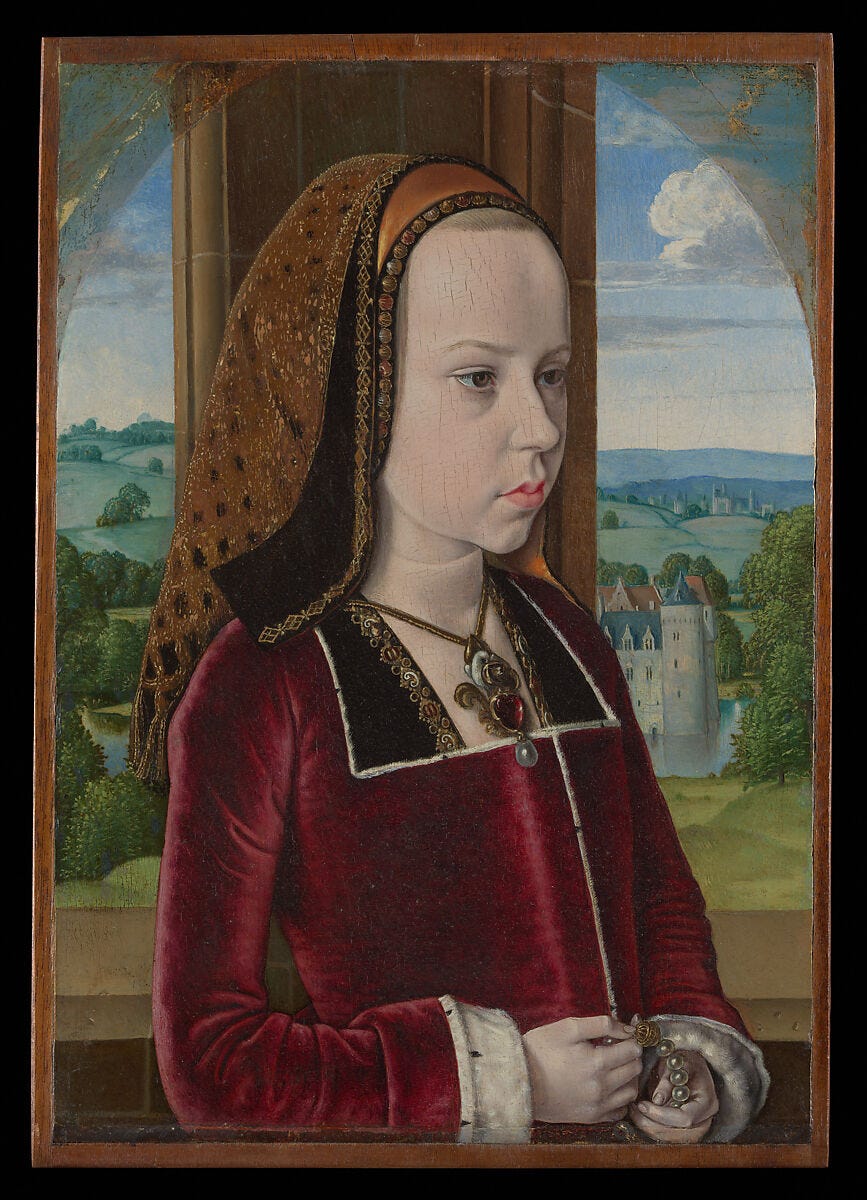
At ten years old, Margaret would have known that another marriage awaited her, but in the meantime, she prepared to return to the Netherlands. She would have looked forward to being reunited with her brother, her step-grandmother, and father, for the first time in nearly a decade.
Of course, it wasn’t so simple. Margaret had brought a brilliant dowry to France, and now arguments ensued over who should keep it. As Anne of Beaujeu and Maximilian sparred over the details, Margaret was continuously shuttled between French strongholds, a captive where she had been queen. Margaret was separated from the women she’d grown up with, losing her governess, her ladies-in-waiting and eventually, and most painfully, her friend Louise of Savoy.
While Anne of Beaujeu used Margaret’s captivity as political capital, Margaret of York worked tirelessly for her release, continuously pressuring Maximilian to accept a compromise and secure Margaret’s return home.
Margaret’s Step-Grandmother, Godmother, and Namesake: Margaret of York
After two years, Margaret finally returned to the Netherlands, arriving on June 12, 1493. Margaret of York and Duke Philip, now fourteen years old, traveled to Cambrai, where the three celebrated a tearful reunion. Philip gifted his sister the Château of Quesnoy as her residence, which had been the first and favorite residence of their mother Mary of Burgundy.9
Margaret had been educated by French women for French ends, so Margaret of York needed to make up for lost time and begin Margaret’s Burgundian education. It was her first opportunity to learn from the guidance of her step-grandmother, and the two Margarets made the most of it. They studied the traditions and history of Burgundy, as well as English and Castilian.
Most importantly, Margaret of York made sure that Mary of Burgundy’s legacy remained alive in her children.10 Mary of Burgundy’s own beloved gouvernante, Jeanne de Halewyn, took up the same role in Margaret of Austria’s household, and Margaret of Austria began to favor residing in Namur, where it was easier for Margaret of York to visit her frequently. The Margarets relished their time together, attending the celebration of Philip’s majority and the festivities around Maximilian’s remarriage, to Bianca Sforza, in 1494.11
Princess of Spain
This was a happy interlude for Margaret of Austria: she developed her own fond memories of the Netherlands before she was inevitably shipped away for the second time. As part of an alliance between the Habsburgs and Spain, thirteen-year-old Margaret now prepared to marry the Prince of Spain, Don Juan: her brother Philip would marry Juan’s sister Juana.
Both marriages, like that of their parents Mary and Max, were romantically successful. Margaret of Austria and the gentle Juan were quickly infatuated with each other, soon smitten. Philip and Juana, meanwhile, were so into each other (despite sharing no language in which to communicate) that their chaplain warned that it would be in everyone’s best interest to formalize their marriage as soon as possible.12
Margaret was in a completely different position as she entered her second marriage. She met Juan and was immediately struck by his reserved, intelligent, but shy demeanor. Margaret was confident, well-educated and well-traveled: it seems that opposites attracted. Margaret and Juan married by procuration on November 5, 1495, before Margaret departed from Fleshing for an ocean voyage to Spain.
Fun fact! Bad weather waylaid Margaret’s flotilla as it departed the Netherlands, so she ended up spending three weeks as a guest at Hampton Court, with King Henry VII. Seriously, it seems that this young woman knew everyone who was anyone at the turn of the sixteenth century.
Margaret’s Mother-in-Law: Isabella I
In Spain Margaret entered what we could call her third political internship, with Isabella I, Queen of Castille.
Isabella of Castile’s political career began at a young age, as she consolidated power during the ineffective rule of her brother and particularly after his death, when she was declared Queen of Castile in 147413. Her marriage in 1469 to Fernando of Aragón united their two kingdoms - Castile and Aragon - but Isabel remained Queen of Castile, sovereign in her own right.14 She was adamant to make decisions and royal policy in her own name, she controlled revenues and government appointments in her realm, and despite a long and fruitful marriage to Ferdinand, when she died Isabella left the inheritance of Castile not to her husband, but to her daughter, Juana.15
This was clearly a woman who innately understood both the opportunities and particular challenges for a woman in power. And Isabella took fondly to Margaret - Juan had never been particularly healthy or virulent, and she believed Margaret’s vitality and joie de vivre would serve him well. The young couple traveled frequently with the court and Isabella: they had the opportunity to observe her political leadership while she also secured the upbringing and marriages of her numerous young children - including Katherine of Aragon, the future Queen of England and first wife of Henry VIII.
This particular balance of personal rule with familial management that Margaret witnessed in Isabella I would turn out to be an essential lesson for Margaret’s future governance.
Don Juan’s health began to decline during the wedding celebrations of his sister Isabella. He’d contracted smallpox and retreated to Salamanca to recover his health. Despite the nature of his illness, Margaret refused to leave his side - advisors urged Isabella to keep Margaret away from Juan, particularly because she was pregnant. But Isabella allowed the insistent Margaret to remain by Juan’s side. In the early modern mindset, the emotional turmoil of a forced separation represented its own threat to the health of the pregnancy.
Don Juan died on October 4, 1497, after six months of marriage. Two months later Margaret endured a labor that lasted for twelve days, but the child she bore died soon after. Margaret was only seventeen years old.
Some historians have written that Isabella blamed Margaret for Juan’s death: that Margaret demanded too much of him sexually, which led to his demise. The same allegations have been made regarding Catherine de Medici and Mary Queen of Scots, the wife of Catherine’s eldest son Francis. But Isabella, like Catherine, seemed to have a perfectly cordial relationship with her daughter-in-law, and both sons had plenty of medical problems before their marriages. This accusation must be recognized for what it was: an unnecessary intrigue elevating the “evil stepmother” trope so popular in early modern chronicles. In reality these Queens were most concerned with political stability. The success of their sons’ marriages was central to the wellbeing of the realm itself.
Widowhood
Margaret was devastated by Don Juan’s death: we can only imagine how she felt, to find a truly happy partnership, after the infortunes of her first marriage, only to lose it so soon. She followed the Spanish court for a time, mourning alongside Isabella.
And now the same script played out again. Margaret remained in Spain, an outsider in the world she had been prepared to rule, as she awaited instructions for where her Habsburg duty would send her next.
Isabella’s husband Ferdinand was unwilling to pay for Margaret’s departure, so Margaret had to raise the funds for her journey herself. Adding insult to injury, Margaret had to abide a reception at the French court in Paris, hosted by her ex-husband Charles VIII, on her way home to the Netherlands. (I know the reception wouldn’t have been intended as an ‘insult,’ but it can’t have been a great time for her, either.)
Margaret arrived home in 1499, just in time for the baptism of her nephew Charles. Margaret was named his godmother - a somewhat auspicious honor, given her future rule on his behalf. Philip and Juana assigned Charles’ upbringing and education to his godmother, Margaret of York. Margaret of Austria was often with Charles and Margaret during this time, enjoying a brief (and unknown to them, final) reunion as she awaited news of her next alliance.
An Introduction to Power: Duchess of Savoy
In a fun twist, Margaret’s third marriage had its roots in her first. Her union with Philibert of Savoy, celebrated in Brussels on September 26, 1501, was a grand success, in part because they’d known each other their entire lives: Philibert and his sister Louise of Savoy had both been members of Anne of Beaujeu’s court from Margaret’s earliest arrival in France. They were also related: Philibert’s mother was sisters with Margaret’s grandmother, Isabelle of Bourbon. Louise of Savoy became a lifelong friend for Margaret, a relationship that would later have massive diplomatic consequences.
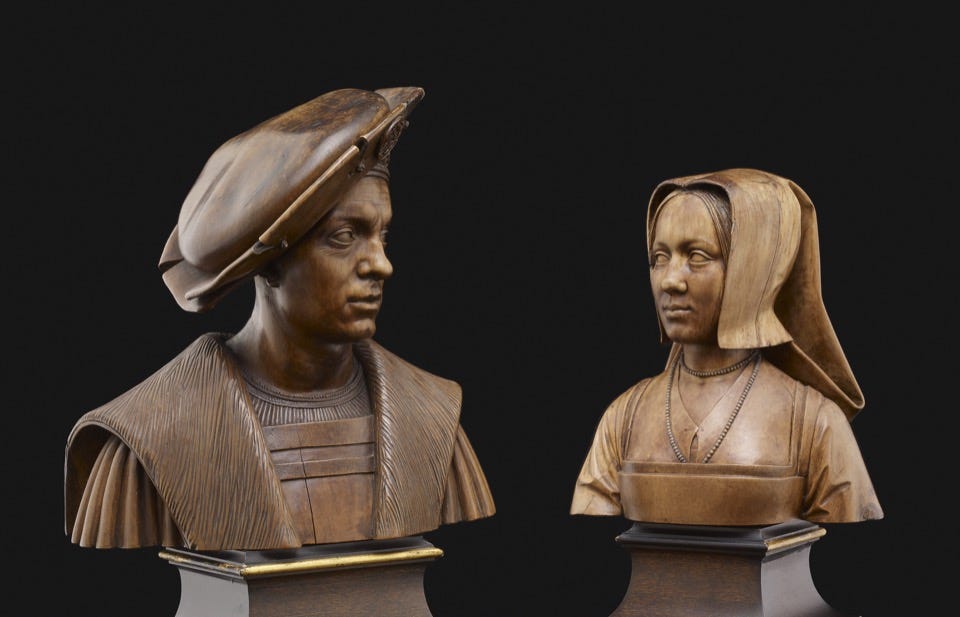
While Margaret had enjoyed what can only be described as “young love” with Don Juan, with Philibert of Savoy she found a true and lasting love. She’d been a child bride and a young princess, and now she became the wife of a sovereign.
Margaret still dressed in mourning for Don Juan when she arrived in Salins for her next marriage. She immediately took center stage as an elaborate ceremony unfolded around her person, her ladies stripping her of her black velvet dress and wrapping her in a gown of gold satin to mark her transition from widow to wife.
Soissons shares a beautiful description of her reunion with Philibert - the first time they saw each other, Philibert swept Margaret into his arms, and they began to dance. Both enjoyed the festivities of court, of dance and poetry and music, traits they clearly relished from the start - their wedding celebrations went on for a month!
Margaret of Austria was finally in a position to make her own way in politics. The three most important role models of her life had been exemplars of female political power, so it is no surprise that Margaret approached her new position with the same thoughtful care as her teachers.
Her training served her well. Philibert was a handsome and chivalrous Duke, but he had little interest in the details of political management. That he left to his half-brother René, who enjoyed an outsized influence in the Savoyard government - some even characterizing him as the true decision maker behind Philibert’s throne. But René was also favorable to French influence in Savoy, providing an opening for Margaret.
Pursuing rumors of treasonous behavior, Margaret had René of Savoy ousted from power, replacing him as Philibert’s primary counselor while René relocated to the French court. From that point forward Margaret was central to the administration of the Duchy of Savoy. Through her maneuvers Margaret expressed “an early aptitude for the business that would one day become her life’s work.”16
Widowed Again
Once again Margaret made a match that brought her personal happiness, and once again her husband was taken from her too soon. In 1504, Philibert died when, after a vigorous hunt, he drank some cold water.
Yes, you read that correctly. Exercise followed by cold refreshment was understood to be a hazardous combination, and Philibert was not the only man in this era who reportedly died this way.17
Margaret was a twice-widowed 25-year-old. She was completely distraught at Philibert’s loss, accounts claiming she’d tried to throw herself from a window in her grief.
This time, she also had political power to count among her losses.18 Margaret had crafted a position of strength at the Court of Savoy, and “constituted a government that over time revealed itself to be one of the best ministerial teams of the sixteenth century.”19 But without a child to claim power in the name of, Philibert was succeeded by his brother, Charles III. Margaret once again found herself fighting for her possessions and wondering where duty would take her next.
A New Approach to Habsburg Service
Margaret had every intention of remaining a widow this time around. Perhaps she had a sense that her streak of comparative good luck - marital bliss, if limited duration - had come to an end.
Meanwhile, Isabella I died, and Philip and Juana inherited the throne in Castile. They undertook a series of journeys to establish their rule there, and though Philip appointed regents in the Netherlands during these absences, he did not appoint Margaret.
Philip had other hopes for his sister: primarily, a fourth marriage. How original. This time, he looked to England. King Henry VII’s daughter Mary would marry Charles, Philip’s eldest son, while Henry VII himself would marry Margaret, making her Queen of England.20
But Margaret was not having it. Instead, when Philip and Juana prepared their second journey to Spain, Margaret traveled to see them in person, to make the case to govern herself. But Philip declined to meet Margaret’s terms, and she returned to her residence in Savoy.
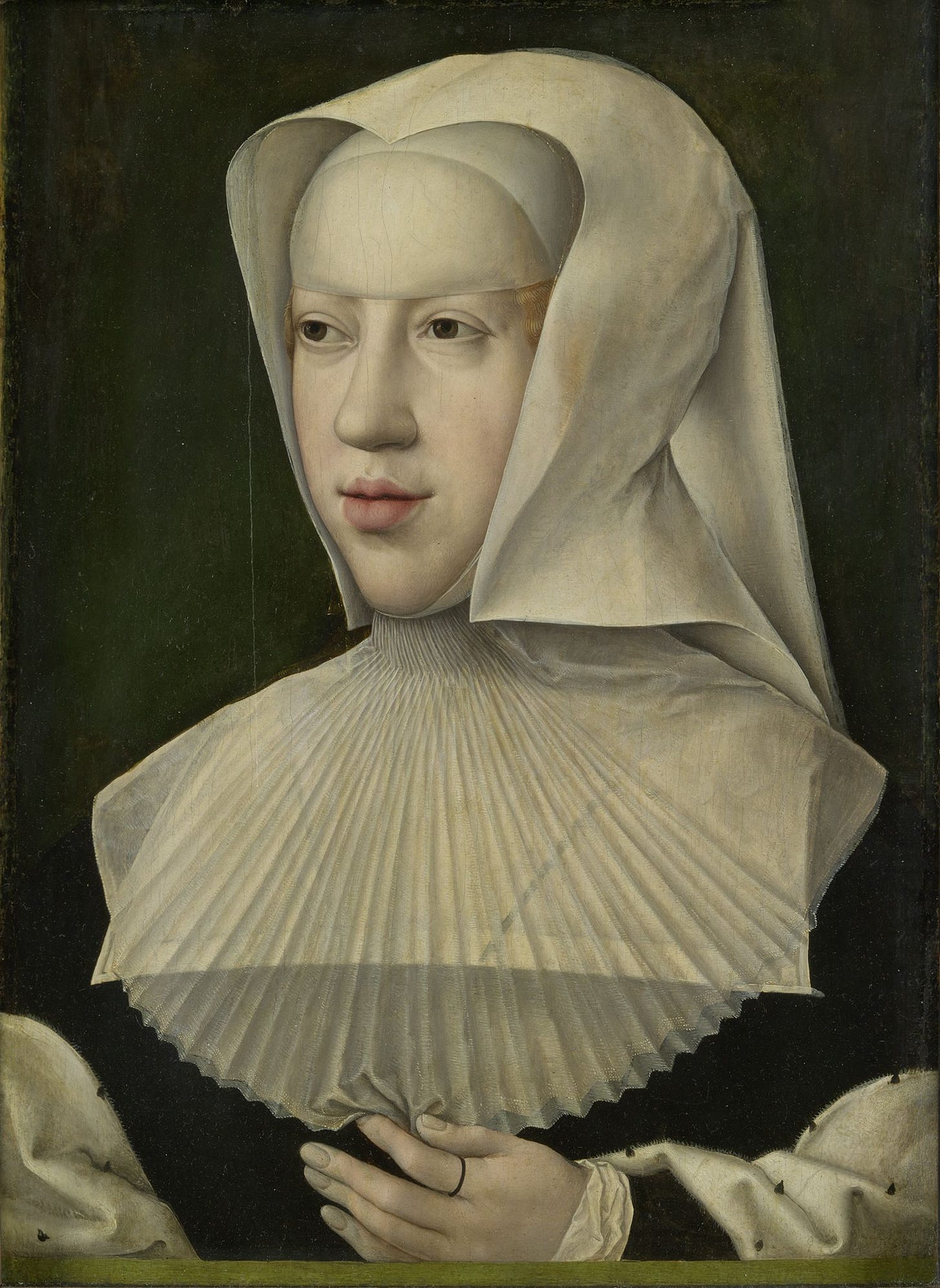
Only the sudden death of her brother saved Margaret from a fourth marriage. In September 1506 Philip found the same end as Philibert of Savoy: exercise followed by a cold glass of water. Philip died, and Juana suffered what was described like a mental breakdown, from which she allegedly never recovered. (I am very hesitant to believe any sources regarding Juana’s mental state, because there’s also sufficient evidence that it served the interests of both her father and son to keep her imprisoned, rather than dealing with her own political initiatives.)
Six-year-old Charles was now Archduke, in need of representatives to rule his patrimony. Margaret’s expertise was more valuable than ever to her nephew; luckily, Henry VII read the room and took his attentions elsewhere.21
A month after Philip died, Margaret left Savoy to return to her father’s side. The Estates General had left Charles’ tutelage to Maximilian, but Maximilian finally realized he would never been accepted as ruler in the Netherlands. He’d made too many enemies in his first attempt, and his Empire and ambitions in Italy required too much of his attention.
But the people still loved and honored Mary of Burgundy. It’s only natural that Maxmilian would turn to his daughter, Mary’s final remaining child, to rule old Burgundy on Charles’ behalf.22
Lessons in Politics, Lessons in Perseverance
Margaret of Austria chose a motto that she would display alongside her coat of arms for the remainder of her life:23
« Fortune, infortune, fort une »
“Fortune and misfortune make one strong”
It strikes me, as a romantic studying an age where romance had nothing to do with marriage (at least among women with power), how lucky Margaret seemed to get in love, at least 2 of 3 times, and how tragic that made the ends of her marriages. I was very familiar with Margaret of Austria’s political career before researching for this story, but it was only recently that I started to appreciate just how sad her early life was. Three times Margaret was thrust into a new kingdom, a new future, with a man she had no choice over, and each time she found a way to love her husband (in the case of Charles, at least in a companionable way).
There is a sadness in her final return to the Netherlands, taking care of children knowing she would never have her own, holding onto pieces of past lives as she settled into a new form of Habsburg service.
But I am mostly fascinated by the ways her political internships across Europe prepared her for her governance in the Netherlands. Margaret was one of the most well-connected women I have ever studied, and while she has long been portrayed as an “exceptional woman,” in reality she was the product of a dazzling network of powerful women. The lessons of this elder generation allowed Margaret to carry forward the ethics of female diplomacy, in her own career and to the women she would raise herself. Margaret was both a product and a proponent of a distinctly feminine political education.
In part II of Margaret of Austria’s story, we’ll get into her career in the Netherlands, the conflicts she faced, and how the political instincts she’d absorbed in her early years helped her become one of the most effective rulers of the early sixteenth century.
Thank you so much for reading! If you’d like to support my work financially, you can do so here:
Louise-Marie Libert, Dames de Pouvoir: Régentes et gouvernantes des anciens Pays-Bas (Paris: Éditions Racine, 2005), 93-98.
Aubrée David-Chapy, Anne de France, Louise de Savoie, inventions d’un pouvoir au féminin (Paris: Classiques Garnier, 2016), 576-7.
Pierre de Bourdeille, Seigneur de Brantôme, Vies des dames illustres françoises et étrangères (Paris: Garnier Frères, 1868), 257. Internet Archive.
Jean-Pierre Soissons, Marguerite: Princesse de Bourgogne (Paris: Bernard Grasset, 2002), 39.
David-Chapy, 684.
Aubrée David-Chapy, “The Political, Symbolic and Courtly Power of Anne of France and Louise of Savoy: From the genesis to the glory of female regency,” in Women and Power at the French Court: 1483-1563, Susan Broomhall, ed. (Amsterdam University Press), 13.
Soissons, 41.
Libert, 99-103.
Lisa Hopkins, Women Who Would Be Kings: Female Rulers of the Sixteenth Century (Vision Press, 1991), 146. Internet Archive.
Soissons, 49.
Libert, 103-108.
Soissons, 52.
Elizabeth A. Lehfedlt, “Ruling Sexuality: The Political Legitimacy of Isabel of Castile,” Renaissance Quarterly 53, no. 1 (Spring, 2000), 34.
Theresa Earenfight, The King’s Other Body: Maria of Castile and the Crown of Aragon (University of Pennsylvania Press, 2010), 140.
M. Lunenfeld, “Isabella I of Castille and the Company of Women in Power,” Historical Reflections / Réflexions Historiques, 4, No. 2 (Winter/l'hiver 1977), 67.
Hopkins, 147.
Historians who know these things generally assume that the death was actually caused by pleurisy, but this is a very vague medical term, and not something that on its own would kill a person - let alone so suddenly. It seems like there must have been some underlying condition or illness which had caused pleurisy, so the workout and ice water combination was a final straw for their already damaged lungs.
Libert, 116.
Soissons, 102.
Liesbeth Geevers, The Spanish Habsburgs and Dynastic Rule, 1500-1700 (Routledge, 2023), 125-126.
Geevers, 126.
Libert, 117.
Dagmar Eichberger, “Instrumentalizing Art for Political Ends: Margaret of Austria, regente et gouvernante des pais bas de l’empereur,” in Femmes de Pouvoir, Femmes Politiques durant les derniers siècles du moyen âge et au cours de la première Renaissance, Bousmar et. al., eds. (Groupe de Boeck, 2012), 580.




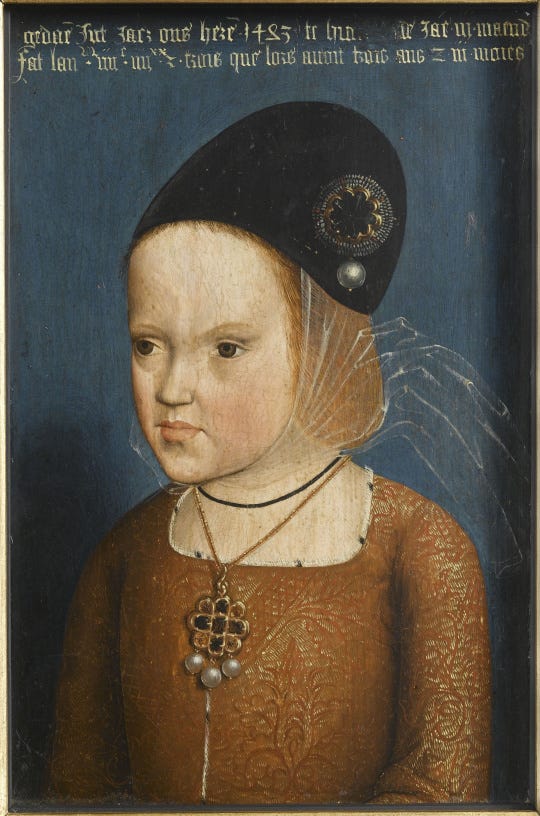
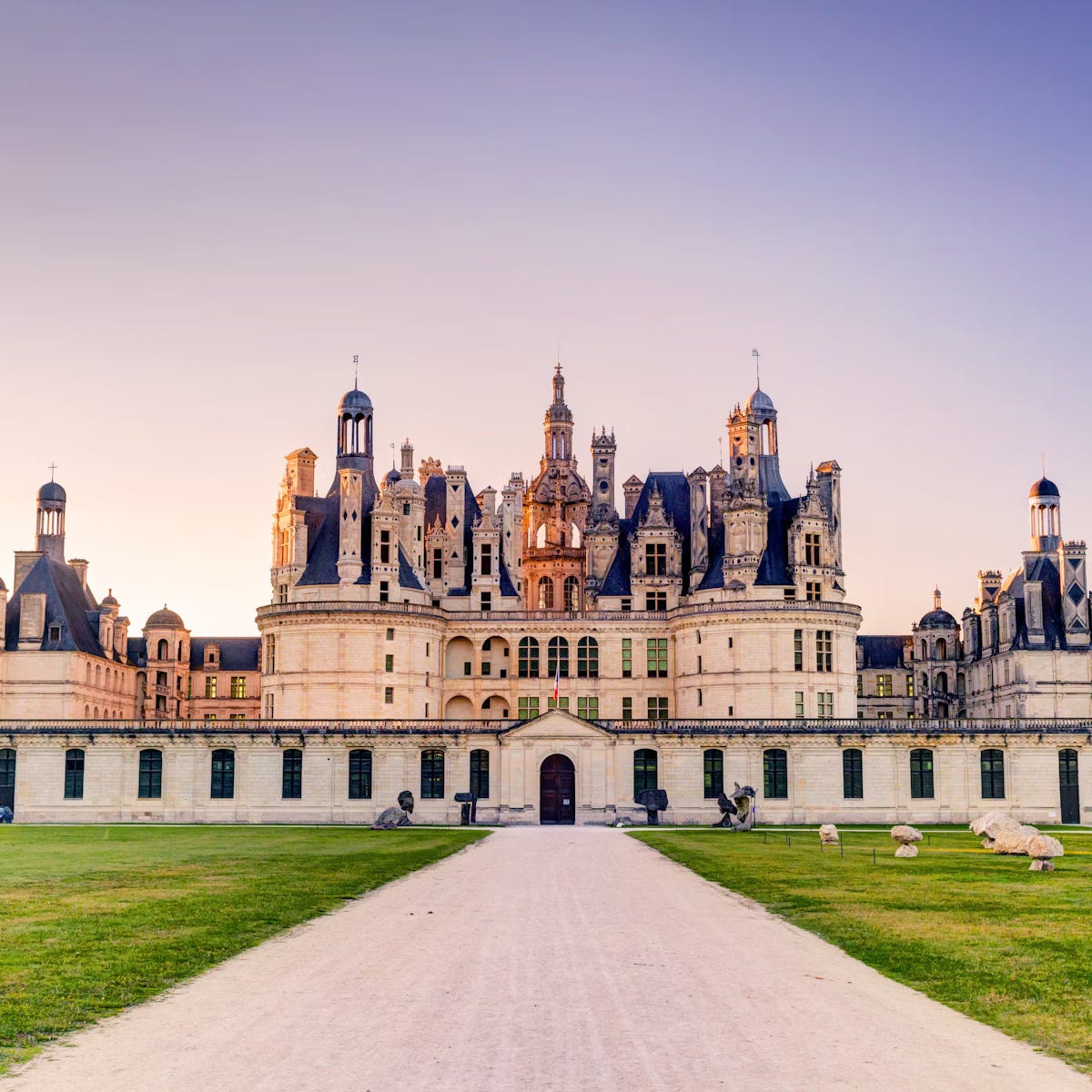

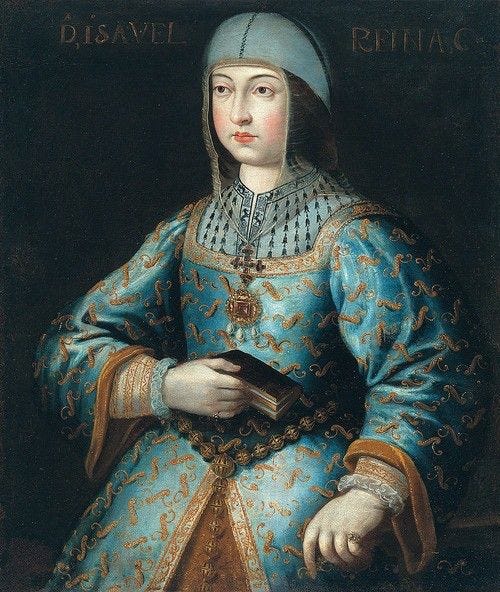

I loved reading this